In this article, you will learn when a slab off is needed for you. In addition, you have different options when it comes to the position of the slab off and the lens designs that can be ordered with a slab off.
A slab off is generally recommended when the difference in needed lens power (anisometropia) causes problems due to the different prismatic effects. Those effects come into play when the wearer of bifocal lenses or progressives perform eye movements up down, for example, to switch from distance vision into the reading distance.
The more the wearer needs to look down the higher those prismatic effects. When the anisometropia exceeds 1.5 diopters problems could come up. Typical problems that speak for a slab off are:
- If the wearer experiences double vision when looking down a slab off is a great idea.
- The wearer experiences extremely uncomfortable vision while reading five minutes. If the discomfort does not go away a prism lens should be applied to the testing frame to compensate for the prismatic effect while the wearer looks down. When this procedure leads to noticeable more comfort a slab off should be applied.
How Does a Slab off Prism Work?
First of all, you need to understand every lens has prismatic effects. They are just there. When you place an object lets say a pen behind a lens and it sits in the middle of this lens you will have no shift of the pictures. Everything looks normal in this example in the picture below.
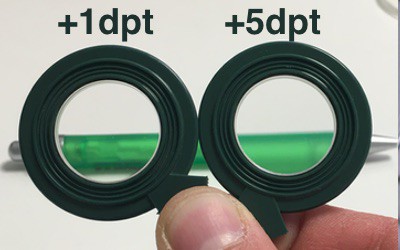
But the problem with double vision and headaches comes as you lower your eyes. As soon as you move from the center of the lenses into the lower part the picture (the pen in this example) shifts its position. And the amount of shift is dependent on the lens power. Have a look at the picture below and compare the images in the lenses.
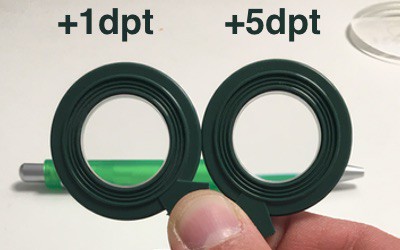
So all you would have to do is to shift the picture up on the right or down on the left and they would be on the same level again. This is when the prism comes into play. It will shift the picture in position.
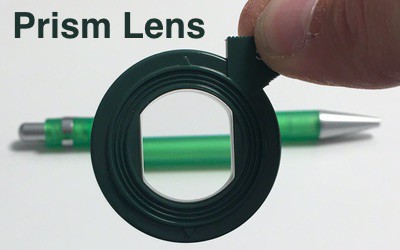
Ass soon as I combined the right position of the right power of the prism in the correct position (base) the pictures are back in an even position. And the problems with the glasses are gone.
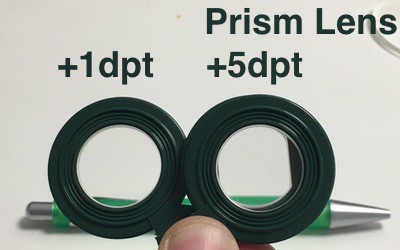
Just a short disclaimer here. The shifting of your eyes will not be as visible as it here is in the example. The reason is the longer distance from the pen to the lens compared from the lens to your eye. It is usually not noticeably.
Here You Can See a Slab off Example
This example shows you the barely noticeable line of a slab off in combination with a progressive lens. You can spot the line as lay the lens down or as you have a closer look at the reflections on the surface. But as soon as the lens sits in front of my face you probably could not notice the line. This is how minimal it is.
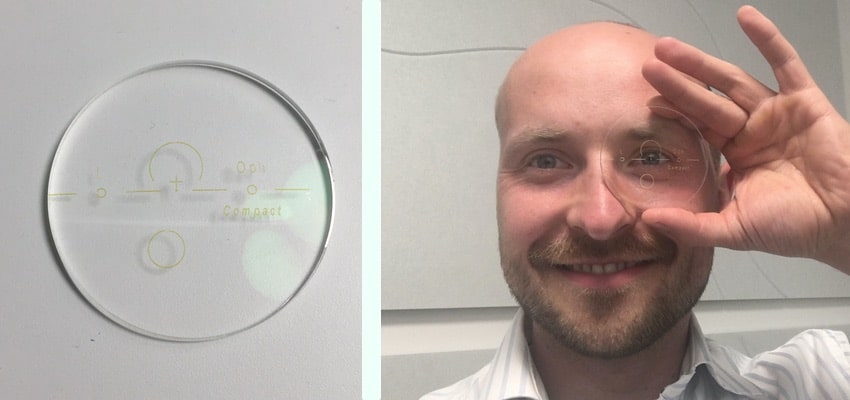
When Is a Slab off Necessary?
A slab off is necessary if your unequal lens power (anisometropia) causes problems as you read with your multifocal lenses (Bifocals or progressives). People with a difference of 1,5D could experience problems. Though the threshold is different for every person. Some people tend to have problems with a difference lower than 1,5D and some wearers of bifocals aren’t bothered at all with a difference bigger than that.
During the eye exam the optician or optometrist gives you two distances far and near. As distance vision gets tested you are looking straight ahead and the optical centers of the lenses in the testing frame sit on the level of your pupil. In this setting you don’t experience any problems. However as you perform eye movements down to read your eyes look though a spot lower than the optical centers.
In this setting some people get blurry vision, double vision, or it feels very tense. If those problems occur the optician then will set a lens with compensation into the frame. In some cases, the customer directly responds with a relaxed face or with the sentence “Wow, this feels good” or “I was able to read it out before but it was stressful. Now it is more even” or in extreme cases:”Double vision is gone! Finally I have one picture again.”

If the mentioned points show up a slab off will be necessary or one of the alternatives. In doubt when the customer accommodates to the imbalance after a few minutes and is able to read out just fine no slab off is recommended.
Which Lens Gets the Slab Off?
The standard slab-off will be found in the stronger minus or weaker plus lens. However, the reverse slab off is ground in the weaker minus, or stronger plus, lens.
| Reverse Slab Off | Slab Off | |
| If both eyes are plus: | select the eye with most plus | select the one with less plus |
| If both eyes are minus: | select the eye with less minus | select with highest minus |
| If one eye is plus and the other minus: | applied to the plus lens | applied to the minus lens |
What Is the Difference Between a Slab off and a Reverse Slab Off?
The standard slab off produces a base-up prism on the back surface. in comparison, the reverse slab off produces a base down prism, and the chosen lens change on which the slab off will be ground in. (Source: Garber NR, Kirdulis T. Slab-off prisms. J Ophthalmic Nurs Technol. 1989;8(4):139‐142.)
Alternatives to a Slab off Grinding
Contact Lenses
If you want to avoid a slab off grinding but you can not tolerate your lenses as they are you have a few alternatives. All that needs to be done ist to minimize the prismatic different effects produced for your pair of eyeglasses. When differences in prismatic effects are high due to different needed lens powers one easy solution is to put a contact lens on one eye.
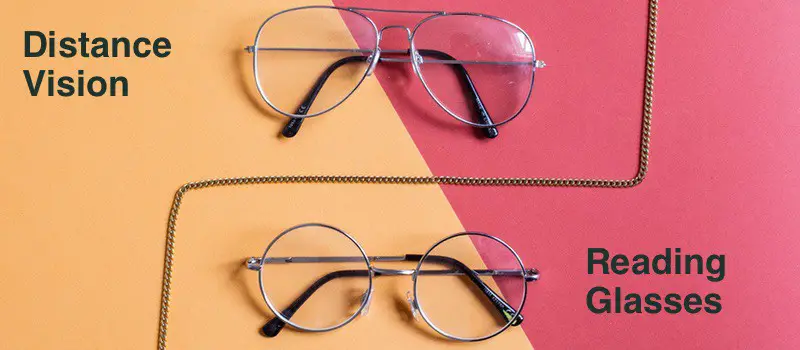
Usually, the more hyperopic eye is the one that wears the contact lens. This way the differences get minimized right away and you could wear your progressives or bifocals easily. Of course, the solution eyeglasses + one contact lens would be your daily driver than because your prescription in your progressive glasses would be adjusted to this special combination.
You could go with soft contact lenses, rigid ones hybrid style lenses. I bet there is a combination that fits you well. Even for dry eyes like scleral contact lenses. But if you do not like this mix for glasses and a contact lens of course you could just go with contact lenses only.
Go With Two Different Glasses for Distance Vision and Reading
When you are forced to perform eye movements with bifocals or progressive lenses different lens powers might cause problems. But if you choose to have two separate glasses you are not forced to perform eye-movements.
If you stick to little smaller shapes for the frames you could just look through the center of the lenses and then you would have fewer problems with the imbalance in lens power.
Get a Shorter Lens Design in Order to Work Around a Slab Off
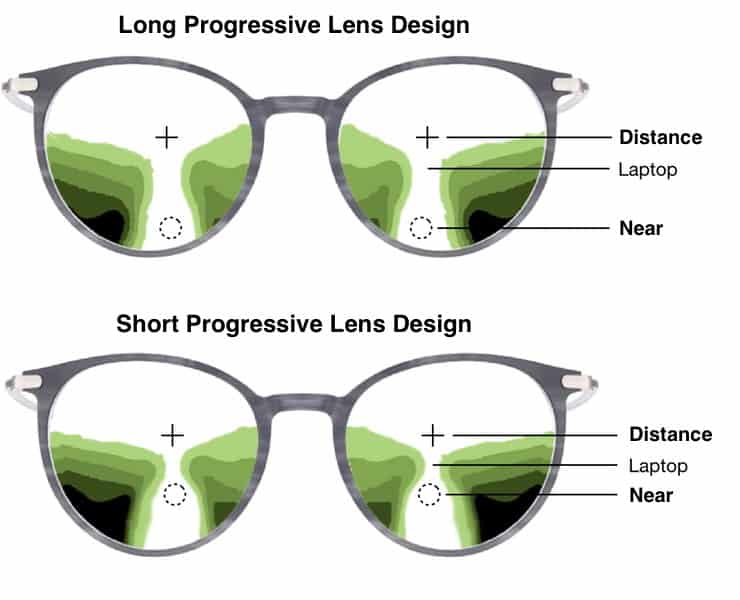
As you saw in the pictures above the more you need to look down in order to reach the reading zone the more you will feel the imbalances of lens powers of your glasses. So if you choose a very short progressive lens design it might be possible for you to work around a slab off.
Get a Lens With an Individually Placed Reading Segment [a Little Higher]
If you do not need to look down as much again because of a little higher placed lens segment you will have less prismatic differences. In a lot of cases, the reading segment is placed 4mm under the middle of your pupils. As this distance gets shorter some people are able to tolerate the glasses better then and avoid the slab off.
Combine Two Different Reading Segments to Work Around a Slab Off
Because of aesthetic reasons, this is definitely not my go-to choice. But of course the shape of the reading segment on each lens determents the vertical prismatic imbalance too. So as you choose different segment shapes you will end up having different positions of the optical center.
Choosing the right shape here is key to manipulate the vertical imbalance of prismatic effects to the wearer’s advantage.

In the same category falls the compensated R segs with an optical center placed differently for each eye to fight vertical prismatic differences. With this option you get a flat top and flat bottom segment with a different shape on the sides of both bifocal lenses.
Lens Designs Available With a Slab Off
- Progressive lenses
- Bifocal lenses
- Trifocal lenses
